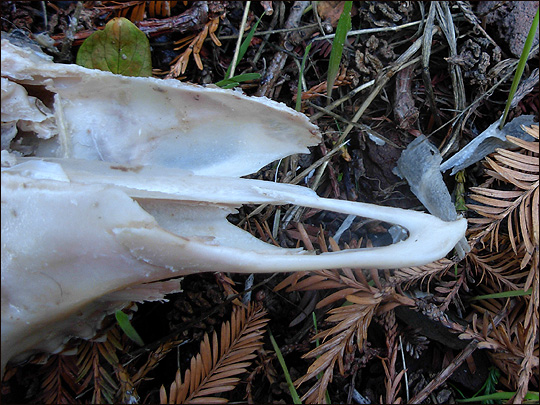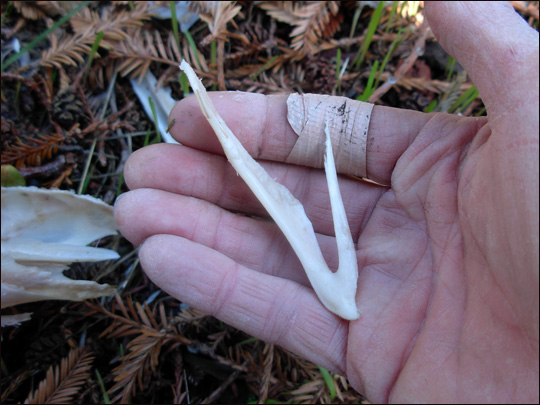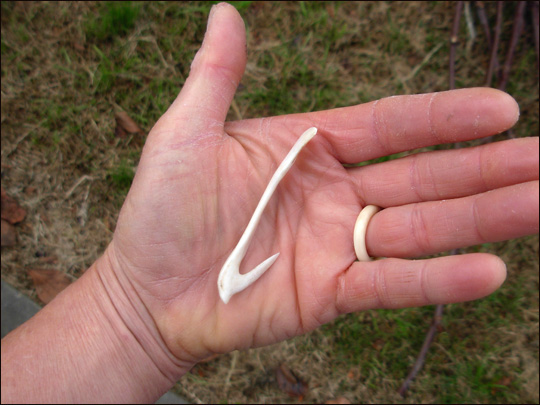
In reading Paul Campbell’s book “Survival Skills of Native California”, I was fascinated by a reference to a “nasal bone” fishhook used by the Wintu of Northern California. Reference to the hook appears again in Ira Jacknis’ “Food in California Indian Culture”. I am somewhat familiar with the bones of ungulate skulls, but couldn’t visualize any nasal bones that were substantial enough to fashion a hook. Then, a friend provided me with a deer hide with a head. The opportunity to explore the question was at my doorstep.
After a bit of boiling and some soaking, I was able to pry apart the nasal cavity. Much of the bone there is extremely fragile, and was damaged as I removed the flesh. But below the nose, in the area that would be the maxilla, or hard palate in us, a bone appeared that was almost perfectly shaped to form a hook.

This photo shows the placement of the “nasal bone” in the skull. The left bone is missing.
Deer have no upper front teeth. This means the bones that usually house the upper front teeth in most animals is far more delicately shaped in a deer. These bones are shaped like a check mark, the classic hook. Very little shaping and a little sharpening is all that is needed to form a fishhook. I suspect this is the bone used by the Wintu . . . . the nasal bone hook referred to by Jacknis and Campbell. I do not know if or how the Wintu finish their hooks, shape them, or how they attach hooks to a line. But it was a nice "Aha!" moment to find the hook-shaped bone.

The photo should help you find these bones. They come in pairs. The hook points align with each other in the center over the hard palate. They are embedded in cartilage beneath the nasal cavity. The shank portion of the bone forms the border of the upper mouth surrounded by the lip.

Final shaping of the hook took less than 10 minutes. Shape is limited by bone strength and the stresses expected in securing the targeted species. In finishing the nasal bone hook, I removed some of the point in order to get down to bony material which was strong. With uncooked bone this is less necessary. Also, shank length need not be as long as that shown here.
If you have ever made a hook from a deer toe bone, you will appreciate the ease with which the “nasal bone” becomes a useful tool.
Have fun trying this. I would be interested in hearing from anyone who is making or using similar hooks.
![]()
We hope the information on the PrimitiveWays website is both instructional and enjoyable. Understand that no warranty or guarantee is included. We expect adults to act responsibly and children to be supervised by a responsible adult. If you use the information on this site to create your own projects or if you try techniques described on PrimitiveWays, behave in accordance with applicable laws, and think about the sustainability of natural resources. Using tools or techniques described on PrimitiveWays can be dangerous with exposure to heavy, sharp or pointed objects, fire, stone tools and hazards present in outdoor settings. Without proper care and caution, or if done incorrectly, there is a risk of property damage, personal injury or even death. So, be advised: Anyone using any information provided on the PrimitiveWays website assumes responsibility for using proper care and caution to protect property, the life, health and safety of himself or herself and all others. He or she expressly assumes all risk of harm or damage to all persons or property proximately caused by the use of this information.
© PrimitiveWays 2016